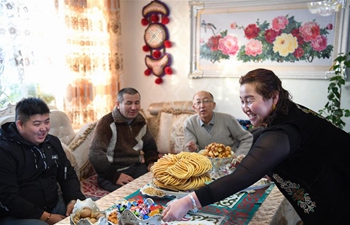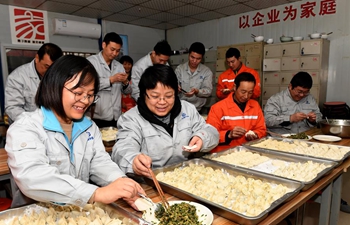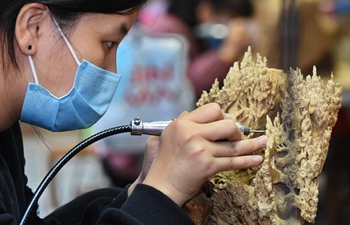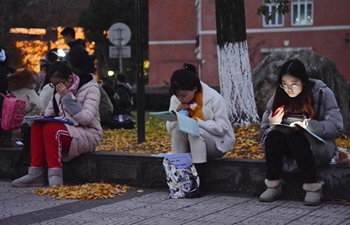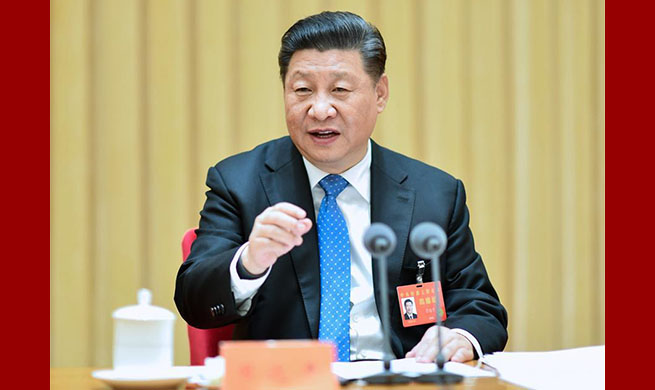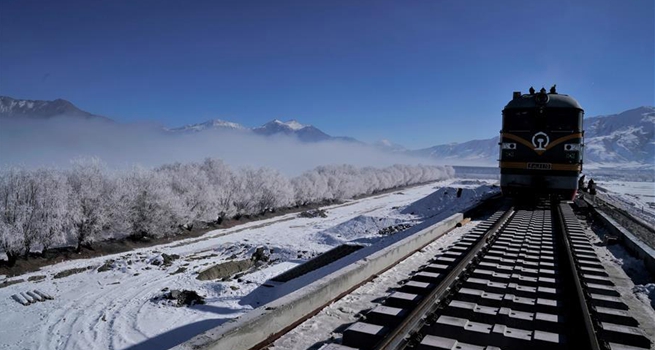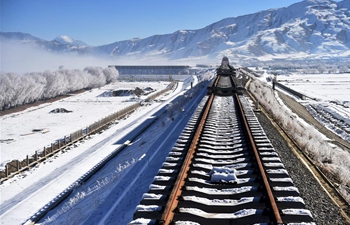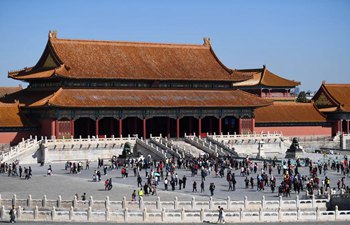by Xinhua writers Zhang Xin, Zhao Wencai
BEIJING, Dec. 24 (Xinhua) -- With a single step forward in truce village Panmunjom on April 27, Kim Jong Un, top leader of the Democratic People's Republic of Korea (DPRK), crossed the concrete block dividing the peninsula into two parts before shaking hands with South Korean President Moon Jae-in. This simple gesture symbolized a significant first step towards peace on the Korean Peninsula.
A total of three inter-Korean summits, three China-DPRK summits and the first-ever DPRK-U.S. summit took place in 2018, making those who were worried by the prospect of a potential nuclear war heave a sigh of relief.
Can the remarkable progress made with efforts of different stakeholders bring long-awaited, lasting peace to the peninsula? Uncertainties remain as the U.S. government has imposed new sanctions on the DPRK and a second Trump-Kim meeting is pending.
HOPE FOR PEACE
On the first day of 2018, despite threatening the United States with "a nuclear button" on his desk, Kim sent a conciliatory message in his New Year's speech that Pyongyang was willing to talk with Seoul if DPRK athletes could attend the 2018 Winter Olympics in South Korea.
This soon became reality at the opening ceremony of the 23rd Winter Olympics in PyeongChang on Feb. 9 as athletes from South Korea and the DPRK marched under one flag with the blue silhouette of the Korean Peninsula in the center, a symbol of peaceful unification, lighting a spark of hope for an inter-Korean rapprochement.
On May 24, within one month after Kim became the first DPRK leader to set foot on South Korean territory since 1953, the DPRK destroyed the tunnels of the Punggye-ri nuclear test site, where it had conducted all its six nuclear tests, and officially announced its dismantlement, marking the onset of the Korean Peninsula's denuclearization.
During a second meeting with Moon on May 26, Kim expressed his "fixed will" to hold a summit with Trump, and promised to further the denuclearization of the peninsula and improve inter-Korean ties.
Kim and Trump finally met on June 12 in Singapore, the first meeting between incumbent leaders of both countries since the 1950-53 Korean War.
According to the "comprehensive" joint statement signed at the Kim-Trump summit, the United States would be committed to providing security guarantees to the DPRK in exchange for Pyongyang's promise of complete denuclearization. Further negotiations between and concrete actions by the two sides were expected.
"Both Washington and Pyongyang achieved some political victories and some strategic benefits this year," said Mark Fitzpatrick, executive director of the International Institute for Strategic Studies-Americas.
The third Kim-Moon summit occurred on Sept. 18, during which the two leaders decided to expand bilateral cooperation in economy, tourism, culture and sports.
Earlier this month, South Korea earmarked 1.1 trillion won (970 million U.S. dollars) for the cooperation fund with the DRPK for 2019. This week, the two sides will hold a groundbreaking ceremony in the DPRK border town of Kaesong to modernize and eventually connect the railway and roads across the inter-Korean border.
"A peace mood has come to the Korean Peninsula," said Lee Sang-man, professor at the Institute for Far Eastern Studies of Kyungnam University in Seoul, in an interview with Xinhua.
CHINA'S CONTRIBUTION
Before his meetings with Trump and Moon, Kim paid a visit to China on March 25, his first foreign trip since assuming office in 2011.
When meeting with Chinese President Xi Jinping, Kim said that "the issue of denuclearization of the Korean Peninsula can be resolved, if South Korea and the United States respond to our efforts with goodwill, create an atmosphere of peace and stability while taking progressive and synchronous measures for the realization of peace," according to an exclusive report by Xinhua.
United Nations (UN) Secretary-General Antonio Guterres said on March 29 he was "extremely encouraged" by Kim's visit to China and praised China as "a very important contributor to a solution in this region."
Two days after the Trump-Kim summit, U.S. Secretary of State Mike Pompeo conveyed Trump's appreciation during a meeting with Xi for the Chinese president's important advice and help over the Korean Peninsula issue, saying the United States is willing to work with China to promote the realization of denuclearization and lasting peace on the peninsula.
While the Korean Peninsula witnessed rapid detente across the demilitarized zone and the Pacific Ocean, Kim's three visits to China were widely believed to have played an indispensable role in laying the groundwork for regional peace.
When meeting with DPRK Foreign Minister Ri Yong Ho in Beijing on Dec. 7, Chinese State Councilor and Foreign Minister Wang Yi called on the DPRK and the United States to resume their dialogue and resolve each other's concerns "in a balanced way," adding that China supports both Koreas in advancing reconciliation and cooperation.
Aiming to foster a peaceful mood on the peninsula, China has put forward a series of solutions including the "dual-track approach" and the "suspension-for-suspension" proposal.
During a phone call with Moon on April 29, Russian President Vladimir Putin stressed the importance of continuing the efforts of all parties involved toward a political and diplomatic settlement on the Korean Peninsula issue following a roadmap proposed by Russia and China.
DPRK-U.S. RELATIONS
While Pyongyang and Seoul have been on the track of forming a closer relationship, DPRK-U.S. relations have seen on-again-off-again twists after the Singapore summit, casting a shadow on the prospect of peace for the Peninsula.
"Unless the DPRK and the United States normalize bilateral relations, inter-Korean relations cannot be developed over the long run," Lee said, indicating that the mistrust between Pyongyang and Washington is undermining the hard-won stability in the region and raising concerns that progress may be shattered.
On Dec. 10, the U.S. Department of Treasury announced new sanctions against three senior DPRK officials for serious human rights abuses and censorship, incurring Pyongyang's wrath over Washington for being "bent on bringing DPRK-U.S. relations back to the status of last year which was marked by exchanges of fire."
Negotiations following the Kim-Trump meeting have also stalled due to differences on a series of key issues including the scale of denuclearization, U.S. sanctions, and whether to issue a war-ending declaration.
Last month, Pompeo emphasized that efforts to restore peace on the Peninsula should move "in parallel with the denuclearization discussions," discouraging the rapid steps taken by both Korean authorities.
At a press conference on Dec. 18, the U.S. State Department's deputy spokesperson Robert Palladino reiterated that the United States will maintain sanctions and pressure against the DPRK until the "final, fully verified denuclearization of the Korean Peninsula" has been achieved.
In response, DPRK's official media the Korean Central News Agency said that the country will not give up its nuclear weapons until the United States has stopped making regional nuclear threats, citing the U.S. troops stationed on South Korean territory and the so-called nuclear umbrella that protects South Korea and Japan.
Earlier this month, Trump revealed that his second meeting with Kim may occur in January or February next year whereas no confirmation has been received from Pyongyang yet.
"Both Trump and Kim want a second summit ... There is always a danger that either side may feel frustrated at the lack of progress and could try to create leverage by building up the tension," said Fitzpatrick.
"Next year, the key point would be the second DPRK-U.S. summit," Lee said. "If Kim and Trump reach a visible agreement and Kim visits Seoul early next year, it would become a game changer."


